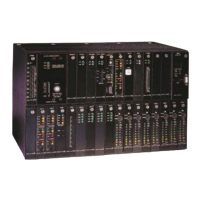Chapter 1. System Overview and Modes of Operation
10
There are many other alarms in the D/I Mux III system. Alarms are rated as major, minor, and
informational. Details of the various alarms are described in Chapter 5. Diagnostics.
Power Failure Alarm
All of the alarm contacts on the D/I Mux III are open during non-alarm conditions. Power failure,
or removing a power supply (or both supplies if redundant DC units are installed), will cause the
visual and audible alarm contacts to close.
Alarm LED Indicators, Alarm Cut-off, and Bypass
The D/I Mux III has Light Emitting Diode (LED) indicators for alarms, alarm cut-off, and bypass.
After an alarm has occurred, an alarm cut-off (ACO) button, or corresponding software selection,
allows the user to turn off the audible alarm relay. The bypass (BYP) button, or software bypass,
allows the D/I Mux III to be bypassed. The bypass button only activates when there is a major
alarm. Bypass is only possible in drop-and-insert or ALPS mode with a Dual Digital Signal Cross-
Connect (DSX-1) interface during a power failure. (A Dual DSX-1 Interface will cause the shelf to
go into bypass immediately if it loses power.) In redundant DC power systems, both power
supplies must fail at any given output before the system enters the bypass mode.
Power Supply Failure Indicator LEDs
The red failure indicator will turn on if any power supply-regulated voltage is out of tolerance, or if
fuses F1, F2, or F3 are blown on, or removed from the -48 V DC power supplies.
In redundant DC power systems, the system software indicates if one power supply has failed.
This allows insertion and removal of either power supply without interrupting service unless both
power supplies are being used to provide power to the channel cards.
Minor Alarm
The minor alarm relay closes for minor alarm reporting. These pins are accessible on the D/I Mux
III backplane, at the contacts labeled MNR. The minor alarm can be activated by the system
reporting a minor alarm, such as a Cyclic Redundancy Code (CRC) error, or redundant power
supply failure. (Refer to Chapter 5. Diagnostics for more information on alarms.)
Bypass
When the D/I Mux III is configured for drop-and-insert operation, bypass causes the T1-1 span to be
connected to the T1-2 span, bypassing the D/I Mux III so that “through T1” is uninterrupted.
The bypass operation can occur automatically, through software selection, or through manipulation of
front panel switches.
When a Dual Digital Signal Cross-Connect (DSX-1) Interface is installed in a D/I Mux III, bypass
automatically occurs when any of the common equipment is removed, or if an out-of-tolerance voltage is
supplied to the system (a brownout occurs). Dual Channel Service Unit (CSU) interfaces do not go into
bypass because protected DC power is used for their operation.
During an alarm condition, bypass can be selected using the bypass switch on the CCU, or AMCU, front
panel. Before bypass can be activated, the alarm condition must be acknowledged by selecting Alarm
Cut-off (ACO) via software, or at the front panel. Bypass can be software-selected at any time.

